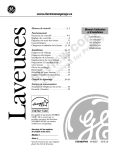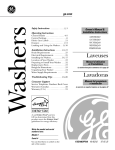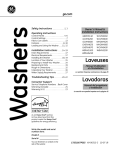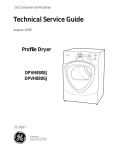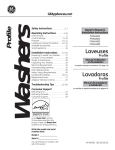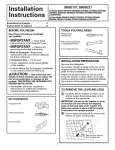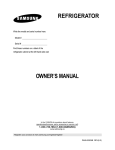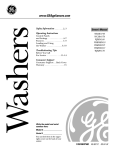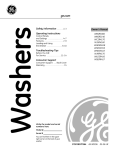Download GE GBVH6260 User's Manual
Transcript
Washers ge.com Safety Instructions . . . . . . . . . . . . 2, 3 Operating Instructions Control Panels . . . . . . . . . . . . . . . . 4–5 Control Settings . . . . . . . . . . . . . . . . . .6 Fabric Care Labels . . . . . . . . . . . . . . .11 Features . . . . . . . . . . . . . . . . . . . . . .7, 8 Loading and Using the Washer . . .9, 10 Installation Instructions . . . . . .12–17 Drain Requirements . . . . . . . . . . . . .15 Electrical Requirements . . . . . . . . . .15 Installing the Washer . . . . . . . . . .16, 17 Location of Your Washer . . . . . . . . . .13 Preparing to Install Your Washer . . .12 Replacement Parts . . . . . . . . . . . . . . .17 Rough-In Dimensions . . . . . . . . . . . .13 Unpacking Your Washer . . . . . . . . . .14 Water Supply Requirements . . . . . . .15 Owner’s Manual & Installation Instructions GBVH6260 GCVH6260 WCVH6260 WBVH6240 WHDVH626 Troubleshooting Tips . . . . . . . . .18–20 Consumer Support Service Telephone Numbers . . . . . . 24 Warranty (Canada) . . . . . . . . . . . . . . 23 Warranty (U.S.) . . . . . . . . . . . . . . . . 22 As an ENERGY STAR® partner, GE has determined that this product meets the ENERGY STAR® guidelines for energy efficiency. Write the model and serial numbers here: Model # __________________ Serial # __________________ You can find them on a label on the side of the washer. 175D1807P476 49-90207 05-05 JR WARNING! For your safety, the information in this manual must be followed to minimize the risk of fire or explosion, electric shock, or to prevent property damage, personal injury, or loss of life. The instructions in this manual and all other literature included with this washer are not meant to cover every possible condition and situation that may occur. Good, safe practices and caution MUST be applied when installing, operating, and maintaining any appliance. WATER HEATER SAFETY Operating Instructions Safety Instructions IMPORTANT SAFETY INFORMATION. READ ALL INSTRUCTIONS BEFORE USING. Under certain conditions hydrogen gas may be produced in a water heater that has not been used for two weeks or more. Hydrogen gas can be explosive under these circumstances. If the hot water has not been used for two weeks or more, prevent the possibility of damage or injury by turning on all hot water faucets and allowing them to run for several minutes. Do this before using any electrical appliance which is connected to the hot water system. This simple procedure will allow any built-up hydrogen gas to escape. Since the gas is flammable, do not smoke or use an open flame or appliance during this process. Installation Instructions PROPER INSTALLATION This washer must be properly installed and located in accordance with the Installation Instructions before it is used. ■ Install or store where it will not be exposed to temperatures below freezing or exposed to the weather, which could cause permanent damage and invalidate the warranty. ■ Properly ground washer to conform with all governing codes and ordinances. Follow details in Installation Instructions. YOUR LAUNDRY AREA ■ Keep the area underneath and around your appliances free of combustible materials such as lint, paper, rags and chemicals. ■ Do not leave the washer door open. An open door Consumer Support Troubleshooting Tips could entice children to hang on the door or crawl inside the washer. 2 ■ Close supervision is necessary if this appliance is used by or near children. Do not allow children to play on, with, or inside this or any other appliance. WHEN USING THE WASHER ■ Never reach into washer while it is moving. Wait until the machine has completely stopped before opening the door. ■ Never attempt to operate this appliance if it is damaged, malfunctioning, partially disassembled, or has missing or broken parts, including a damaged cord or plug. cleaning solvents, kerosene, etc.) which may ignite or explode. Do not add these substances to the wash water. Do not use or place these substances around your washer or dryer during operation. automatically restart after a cool-down period of up to 2 hours, if the washer has not been manually turned off during this time. ■ The laundry process can reduce the flame Installation Instructions retardancy of fabrics. To avoid such a result, carefully follow the garment manufacturer’s wash and care instructions. ■ To minimize the possibility of electric shock, unplug this appliance from the power supply or disconnect the washer at the building’s distribution panel by removing the fuse or switching off the circuit breaker before attempting any maintenance or cleaning. NOTE: Pressing the power button does NOT disconnect the appliance from the power supply. ■ Turn off water faucets to relieve pressure on ■ Do not attempt to repair or replace any part of hoses and valves and to minimize leakage if a break or rupture should occur. Check the condition of the fill hoses; they should be replaced every 5 years. this appliance unless specifically recommended in this Owner’s Manual, or in published userrepair instructions that you understand and have the skills to carry out. ■ Do not tamper with controls. from service, remove the washer door to prevent children from hiding inside. Consumer Support READ AND FOLLOW THIS SAFETY INFORMATION CAREFULLY. SAVE THESE INSTRUCTIONS Troubleshooting Tips WHEN NOT IN USE ■ Before discarding a washer, or removing it Operating Instructions Use this ■ Do not mix chlorine bleach with ammonia or appliance acids such as vinegar and/or rust remover. ■ Do not slam the washer door closed. Do not try only for its Mixing different chemicals can produce a toxic to force the door open when locked (LOCKED intended gas which may cause death. indicator ON). This could result in damage to purpose as the washer. described in ■ Do not wash or dry articles that have been cleaned in, washed in, soaked in, or spotted with ■ The washer is equipped with an electrical this Owner’s combustible or explosive substances (such as overload protector. The motor will stop Manual. wax, oil, paint, gasoline, degreasers, dryif it becomes overheated. The washer will Safety Instructions ge.com 3 Safety Instructions About the washer control panel. You can locate your model number at the top inside of the door opening. Model WCVH6260 6 1 11 10 9 PRE WASH EXTRA RINSE SPIN DELAY DOOR LOCKED Troubleshooting Tips Installation Instructions Operating Instructions EASY CARE ACTIVE WEAR DELICATES STAIN WASH HANDWASH COLORS/ NORMAL SPEED WASH WHITES RINSE & SPIN HOLD 3 SEC TO STORE MY CYCLE 8 2 12 7 3 4 5 Model WHDVH626 6 1 8 2 12 11 10 7 9 3 4 5 Model WBVH6240 6 1 11 10 9 PRE WASH EXTRA RINSE SPIN DELAY DOOR LOCKED Consumer Support ACTIVE WEAR DELICATES HANDWASH SPEED WASH EASY CARE STAIN WASH DRAIN & SPIN COLORS/ NORMAL RINSE & SPIN WHITES 2 4 8 7 3 4 5 Model GBVH6260 6 1 Operating Instructions Installation Instructions Troubleshooting Tips 5 4 3 7 8 2 12 9 11 10 6 1 5 4 3 7 8 2 12 11 10 9 Model GCVH6260 Consumer Support 5 Safety Instructions ge.com Safety Instructions About the washer control panel. 1 Power Press to “wake up” the display. If the display is active, press to put the washer into standby mode. NOTE: Pressing POWER does not disconnect the appliance from the power supply. 2 Wash Cycles The wash cycles are optimized for specific types of wash loads. The chart below will help you match the wash setting with the loads. WHITES Operating Instructions COLOR/NORMAL STAIN WASH EASY CARE (PERMA PRESS) ACTIVE WEAR Installation Instructions DELICATES For heavy soiled colorfast cottons, household linens, work and play clothes. For wrinkle-free and permanent press items. For active sports, exercise and some casual wear clothes. Fabrics include modern technology finishes and fibers such as spandex, stretch and micro-fibers. For lingerie and special-care fabrics with light to normal soil. Provides gentle tumbling and soak during wash and rinse. For items labeled hand-washable with light soils. Provides gentle rocking to mimic the handwashing action. WOOLMARK The wool wash cycle of this machine has been approved by Woolmark® for the washing of machine washable Woolmark® products provided that the products are washed according to the instructions on the garment label and those issued by the manufacturer of this washing machine. SPEED WASH Troubleshooting Tips For heavy to lightly soiled colorfast cottons, household linens, work and play clothes. HANDWASH MY CYCLE Consumer Support For heavily to lightly soiled white cottons, household linens, work and play clothes. Press to use, create, or modify custom wash cycles. For lightly soiled items that are needed in a hurry. Cycle time is approximately 30 minutes, depending on selected options. DRAIN & SPIN Drain and spin at any time. RINSE & SPIN To quickly rinse out any items at any time. 3 Soil Level 4 Spin Speed 5 Wash Temp Changing the SOIL LEVEL increases or decreases the wash time to remove different amounts of soil. To change the SOIL LEVEL, press the SOIL LEVEL button until you have reached the desired setting. You can choose between Extra Light, Light, Normal or Heavy soil. Changing the SPIN SPEED changes the final spin speed of the cycles. Always follow the fabric manufacturer’s care label when changing the SPIN SPEED. To change the SPIN SPEED, press the SPIN SPEED button until you have reached the desired setting. Higher spin speeds are not available on certain cycles, such as Delicates. Higher spin speeds remove more water from the clothes and will help reduce dry time, but may also increase the possibility of setting wrinkles on some fabrics. Adjust to select the proper water termperature for the wash cycle. The prewash and rinse water is always cold to help reduce energy usage and reduce setting of stains and wrinkles. Follow the fabric manufacturer’s care label when selecting the wash temperature. To change the wash temperature, press the WASH TEMP button until you have reached the desired setting. The Sanitized wash temperature is not available on certain cycles, such as Delicates. NOTE: The first 10 seconds of the wash fill is always cold. This feature assists in conditioning the fabric and preventing stains from setting on garments. 6 6 START/PAUSE Press to start a wash cycle. If the washer is running, pressing it once will pause the washer and unlock the door. Press again to restart the wash cycle. NOTE: If the washer is paused and the cycle is not restarted within 2 hours, the current wash cycle will be cancelled. About the washer features. ge.com Cycle Signal 7 Use the SIGNAL button to change the volume of the end of cycle signal. Press the button until you reach the desired volume. Prewash 8 Operating Instructions Prewash is an extra wash before the main wash. Use it for heavily soiled clothes or for clothes with a care label that recommends prewashing before washing. Be sure to add high-efficiency detergent, or the proper wash additive to the prewash dispenser. Extra Rinse 9 Use an extra rinse when additional rinsing is desired to remove excess dirt and detergent from soiled loads. You can delay the start of a wash cycle for up to 12 hours. Press the DELAY START button to choose the number of hours you want to delay the start of the cycle, then press the START button. The machine will count down and start automatically at the correct time. NOTE: If you forget to fully close the door, a reminder signal will beep reminding you to do so. NOTE: If you open the door when the delay is counting down, the machine will enter the pause state. You must close the door and press START again in order to restart the countdown. You can lock the controls to prevent any selections from being made. Or you can lock the controls after you have started a cycle. To lock the washer, press and hold the lock button for 3 seconds. To unlock the washer controls, press and hold the lock button for 3 seconds. Children cannot accidentally start the washer by touching pads with this option selected. The control lock icon on the display will light up when it is on. NOTE: The POWER button can still be used when the machine is locked. Troubleshooting Tips Lock 11 Installation Instructions Delay Start 10 Safety Instructions NOTE: Features may not be available on all washer models. MY CYCLE HOLD 3 SEC TO STORE MY CYCLE To save a favorite cycle, set the desired settings and hold down the MY CYCLE button for 3 seconds. A beep will sound to indicate the cycle has been saved. To use your custom cycle, press the MY CYCLE button before washing a load. To change the saved cycle, set the desired settings and hold down the MY CYCLE button for 3 seconds. NOTE: When using MY CYCLE, wash options cannot be modified after the cycle has been started. NOTE: If you change wash options with MY CYCLE before starting the cycle, the MY CYCLE light will turn off and you will be returned to the base cycle. 7 Consumer Support 12 NOTE: Features may not be available on all washer models. The Dispenser Drawer Slowly open the dispenser drawer by pulling it out until it stops. After adding laundry products, slowly close the dispenser drawer. Closing the drawer too quickly could result in early dispensing of the bleach, fabric softener or detergent. You may see water in the bleach and fabric softener compartments at the end of the cycle. This is a result of the flushing/siphoning action and is part of the normal operation of the washer. The Prewash Compartment ■ Only use the Prewash Compartment if you are selecting the Prewash cycle for heavily soiled clothes. Add measured detergent or prewash additive to the back left prewash compartment of the dispenser drawer. ■ Detergent or prewash additive is flushed from the dispenser in the prewash cycle (if selected). Powder Icons Insert in rear position for powder detergent Liquid Icons NOTE: Liquid detergent will drain into the washer drum as it is added. ■ Detergent usage may need to be adjusted for water temperature, water hardness, size and soil level of the load. Avoid using too much detergent in your washer as it can lead to over sudsing and detergent residue being left on the clothes. The Detergent Compartment ■ High efficiency detergent is recommended for this washer. Use the detergent manufacturer’s recommended amount. Move the insert by pulling it up and replace it by sliding it down between either the rear or front detergent compartment molded rails, as desired, for powder or liquid detergent. The detergent selection insert must be placed in the detergent compartment in a specific position according to what type of detergent you are using. ■ Add measured detergent to the front left detergent compartment of the dispenser drawer. ■ Powder Detergent – Place the insert in the rear position. The Powder Icons must line up on center when the insert is in the powder position. Insert in forward position for liquid detergent ■ Liquid Detergent – Place the insert in the forward position. The Liquid Icons must line up on center when the insert is in the liquid position. ■ Detergent is flushed from the dispenser at the beginning of the wash cycle. Either powdered or liquid detergent can be used. ■ Detergent usage may need to be adjusted for water temperature, water hardness, size and soil level of the load. Avoid using too much detergent in your washer as it can lead to oversudsing and detergent residue being left on the clothes. The Liquid Bleach Compartment If desired, measure out the recommended amount of liquid bleach, not to exceed 1/3 cup (80 ml) and pour into the center compartment labeled “LIQUID BLEACH” marked with this symbol . Consumer Support Troubleshooting Tips Installation Instructions Operating Instructions Safety Instructions About the washer features. Do not exceed the maximum fill line. Overfilling can cause early dispensing of the bleach which could result in damaged clothes. NOTE: Do not use powdered bleach in the dispenser. The Fabric Softener Compartment If desired, pour the recommended amount of liquid fabric softener into the compartment labeled “FABRIC SOFTENER.” Use only liquid fabric softener in the dispenser. 8 Dilute with water to the maximum fill line. Do not exceed the maximum fill line. Overfilling can cause early dispensing of the fabric softener which could stain clothes. NOTE: Do not pour fabric softener directly on the wash load. Loading and using the washer. ge.com Sorting Wash Loads Sort laundry into loads that can be washed together. Colors Soil Fabric Lint Whites Heavy Delicates Lint Producers Lights Normal Easy Care Lint Collectors Darks Light Sturdy Cottons Operating Instructions ■ Combine large and small items in a load. Load large items first. Large items should not be more than half the total wash load. ■ Washing single items is not recommended. This may cause an out-of-balance load. Add one or two similar items. ■ Pillows and comforters should not be mixed with other items. This may cause an out-of-balance load. Loading the Washer To add items after washer has started, press START/PAUSE and wait until the door is unlatched. The washer may take up to 30 seconds to unlock the door after pressing START/PAUSE depending on the machine conditions. Do not try to force open the door when it is locked. After the door unlocks, open gently. Add items, close the door and press START/PAUSE to restart. Care and Cleaning Exterior: Immediately wipe off any spills. Wipe with damp cloth. Do not hit surface with sharp objects. Troubleshooting Tips Interior: Dry around the washer door opening, flexible gasket and door glass. These areas should always be clean to ensure a water tight seal. Installation Instructions Wash drum may be fully loaded with loosely added items. Do not wash fabrics containing flammable materials (waxes, cleaning fluids, etc.). Safety Instructions Always follow fabric manufacturer’s care label when laundering. Moving and Storage: Ask the service technician to remove water from drain pump and hoses. Do not store the washer where it will be exposed to the weather. When moving the washer, the tub should be kept stationary by using the shipping bolts removed during installation. See Installation Instructions in this book. If these parts are not available, they can be ordered by visiting our Website at www.GEAppliances.com or by calling 800.GE.CARES. Long Vacations: Be sure water supply is shut off at faucets. Drain all water from hoses if weather will be below freezing. Consumer Support 9 Always follow fabric manufacturer’s care label when laundering. Dispenser Drawer Area: Detergent and fabric softener may build up in the dispenser drawer. Residue should be removed once or twice a month. ■ Remove the drawer by first pulling it out until it stops. Then reach back into the left rear corner of the drawer cavity and press down firmly on the lock tab, pulling out the drawer. Lock tab is visible only after drawer has been pulled out ■ Remove the inserts from the bleach and fabric softener compartments and the detergent insert. Rinse the inserts and the drawer with hot water to remove traces of accumulated laundry products. Installation Instructions Operating Instructions Safety Instructions Loading and using the washer. ■ To clean the drawer opening, use a small brush to clean the recess. Remove all residue from the upper and lower parts of the recess. Consumer Support Troubleshooting Tips ■ Return inserts to the proper compartments. Replace the dispenser drawer. 10 ge.com Fabric Care Labels Below are fabric care label “symbols” that affect the clothing you will be laundering. WASH LABELS Normal Water temperature Permanent Press/ wrinkle resistant Hot (50°C/120°F) Gentle/ delicate Hand wash Warm (40°C/105°F) Do not wash Operating Instructions Machine wash cycle Do not wring Cold/cool (30°C/85°F) BLEACH LABELS Any bleach (when needed) Only non-chlorine bleach (when needed) Installation Instructions Bleach symbols Safety Instructions About the washer features. Do not bleach Troubleshooting Tips Consumer Support 11 Installation Instructions Washer Models GBHV6260 GCVH6260 WCVH6260 WBVH6240 WHDVH626 If you have any questions, call 800.GE.CARES (800.432.2737) or visit our Website at: ge.com TOOLS REQUIRED FOR WASHER INSTALLATION BEFORE YOU BEGIN Read these instructions completely and carefully. • ❏ 1/4″ nut driver IMPORTANT – Save these ❏ 3/8″ socket with ratchet instructions for local inspector’s use. ❏ 3/8″ open-end wrench • IMPORTANT – Observe all governing codes and ordinances. ❏ Adjustable wrench or 7/16″ socket with ratchet • Note to Installer – Be sure to leave these ❏ Adjustable wrench or 9/16″ open-end wrench • • • • • instructions with the Consumer. Note to Consumer – Keep these instructions for future reference. Skill level – Installation of this appliance requires basic mechanical and electrical skills. Completion time – 1-3 hours Proper installation is the responsibility of the installer. Product failure due to improper installation is not covered under the Warranty. ❏ Channel-lock adjustable pliers ❏ Carpenter’s level PARTS SUPPLIED ❏ Cable Tie FOR YOUR SAFETY: ❏ Water Hoses (2) WARNING • This appliance must be properly grounded and installed as described in these Installation Instructions. ❏ Hose Guide • Do not install or store appliance in an area where it will be exposed to water/weather. See Location of Your Washer section. • NOTE: This appliance must be properly grounded, and electrical service to the washer must conform with local codes and ordinances and the latest edition of the National Electrical Code, ANSI/NFPA 70. 12 Installation Instructions LOCATION OF YOUR WASHER ROUGH-IN DIMENSIONS Do Not Install the Washer: FRONT 1. In an area exposed to dripping water or outside weather conditions. The ambient temperature should never be below 60°F (15.6°C) for proper washer operation. 27.0” (68.6 cm) 20.4” (51.9 cm) 2.2” (5.6 cm) ELECTRONIC TRANSPARENT VISOR 2. In an area where it will come in contact with curtains or drapes. 3. On carpet. The floor MUST be a hard surface with a maximum slope of 1/2″ per foot (1.27 cm per 30 cm). To make sure the washer does not vibrate or move, you may have to reinforce the floor. 40.6”* (103.1 cm) NOTE: If floor is in poor condition, use 3/4″ impregnated plywood sheet solidly attached to existing floor covering. IMPORTANT: Minimum Installation Clearances • When installed in alcove: Sides, Rear, Top = 0″ (0 cm) • When installed in closet: Sides, Rear, Top = 0″ (0 cm), Front = 1″ (2.54 cm) • Closet door ventilation openings required: 2 louvers each 60 square in. (387 cm2), located 3″ (7.6 cm) from top and bottom of door SIDE 30.6” (77.7 cm) 1.6” (3.9 cm) 40.6”* (103.1cm) 39.1” (99.2 cm) *NOTE: With pedestal, 52.6”. 13 Installation Instructions UNPACKING THE WASHER WARNING: Recycle or destroy the carton and plastic bags after the washer is unpacked. Make materials inaccessible to children. Children might use them for play. Cartons covered with rugs, bedspreads, or plastic sheets can become airtight chambers causing suffocation. 1. Cut and remove the top and bottom packaging straps. 2. While it is in the carton, carefully lay the washer on its side. DO NOT lay the washer on its front or back. 3. Turn down the bottom flaps—remove all base packaging, including the cardboard, styrofoam base and styrofoam tub support (inserted in center of base). NOTE: If you are installing a pedestal, proceed to the installation instructions that come with the pedestal. 4. Carefully return the washer to an upright position and remove the carton. 5. Carefully move the washer to within 4 feet (122 cm) of the final location. 6. Remove the following from the back side of the washer: 4 bolts 4 plastic spacers (including rubber grommets) 4 power cord retainers NOTE: Failure to remove the shipping braces can cause the washer to become severely unbalanced. Save all bolts for future use. NOTE: If you must transport the washer at a later date, you must reinstall the shipping support hardware to prevent shipping damage. Keep the hardware in the plastic bag provided. 14 Installation Instructions WATER SUPPLY REQUIREMENTS ELECTRICAL REQUIREMENTS Hot and cold water faucets MUST be installed within 42 inches (107 cm) of your washer’s water inlet. The faucets MUST be 3/4″ (1.9 cm) garden hose-type so inlet hoses can be connected. Water pressure MUST be between 10 and 120 pounds per square inch. Your water department can advise you of your water pressure. The hot water temperature should be set to deliver water at 120° to 140°F (48°–60°C). Read these instructions completely and carefully. CIRCUIT – Individual, properly polarized and grounded 15-amp branch circuit fused with 15-amp time-delay fuse or circuit breaker. POWER SUPPLY – 2-wire, with ground, 120-volt, singlephase, 60-Hz, Alternating Current. OUTLET RECEPTACLE – Properly grounded 3-prong receptacle to be located so the power supply cord is accessible when the washer is in an installed position. DRAIN REQUIREMENTS 1. Drain capable of eliminating 17 gals (64.3 L) per minute. 2. A standpipe diameter of 1 1/4″ (3.18 cm) minimum. 3. The standpipe height above the floor should be: Minimum height: 24″ (61 cm) Maximum height: 96″ (244 cm) BACK 96 in. (244 cm) Max. GROUNDING REQUIREMENTS 24 in. (61 cm) Min. WARNING: Improper connection of the equipment grounding conductor can result in a risk of electrical shock. Check with a licensed electrician if you are in doubt as to whether the appliance is properly grounded. NOTE: The drain hose attached to the washer can reach a 58″ (147 cm) high standpipe. For a higher standpipe, contact an authorized parts distributor. 1. The washer MUST be grounded. In the event of malfunction or breakdown, grounding will reduce the risk of electrical shock by providing a path of least resistance for electrical current. 2. Since your washer is equipped with a power supply cord having an equipment-grounding conductor and a grounding plug, the plug MUST be plugged into an appropriate, copper-wired receptacle that is properly installed and grounded in accordance with all local codes and ordinances or in the absence of local codes, with the National Electrical Codes, ANSI/NFPA 70 (latest edition). If in doubt, call a licensed electrician. DO NOT cut off or alter the grounding prong on the power supply cord. In situations where a two-slot receptacle is present, it is the owner’s responsibility to have a licensed electrician replace it with a properly grounded three-prong grounding-type receptacle. 15 Installation Instructions INSTALLING THE WASHER 5. Carefully move the washer to its final location. Gently rock the washer into position. 1. Run some water from the hot and cold faucets to flush the water lines and remove particles that might clog up the water valve screens. NOTE: Do not use the dispenser drawer or door to lift the washer. 2. Remove the inlet hoses from the plastic bag. NOTE: If you are installing into a drain pan, you can use a 24-inch long 2x4 to lever the washer into place. 3. (90° elbow end) Carefully connect the inlet hose marked HOT to the outside “H” outlet of the water valve. Tighten by hand, then tighten another 2/3 turn with pliers. Carefully connect the other inlet hose to the inside “C” outlet of the water valve. Tighten by hand; then tighten another 2/3 turn with pliers. Do not crossthread or over-tighten these connections. 6. With the washer in its final position, place a level on top of the washer (if the washer is installed under a counter, the washer should not be able to rock). Adjust the front leveling legs up or down to ensure the washer is resting solid. Turn the lock nuts on each leg up towards the base of the washer and snug with a wrench. 4. Connect the inlet hose ends to the HOT and COLD water faucets tightly by hand, then tighten another 2/3 turn with pliers. Turn the water on and check for leaks. NOTE: Keep the leg extension at a minimum to prevent excessive vibration. The farther out the legs are extended, the more the washer will vibrate. If the floor is not level or is damaged, you may have to extend the rear leveling legs. 16 Installation Instructions 9. Turn on the power at a circuit breaker/fuse box. INSTALLING THE WASHER (cont.) 10. Read the rest of this Owner’s Manual. It contains valuable and helpful information that will save you time and money. 7. Attach U-shaped hose guide to the end of the drain hose. Place the hose in a laundry tub or standpipe and secure it with the cable tie provided in the enclosure package. 11. Before starting the washer, check to make sure: ❏ ❏ ❏ ❏ ❏ NOTE: If the drain hose is placed in a standpipe without forming a U shape, a siphoning action could occur. There must be an air gap around the drain hose. A snug hose fit can also cause a siphoning action. Main power is turned on. The washer is plugged in. The water faucets are turned on. The unit is level. The shipping support hardware is removed and saved. ❏ The drain hose is properly tied up. ❏ There are no leaks at the faucet, drain line or washer. 12. Run the washer through a complete cycle. Check for water leaks and proper operation. Cable Tie 13. If your washer does not operate, please review the Before You Call For Service section before calling for service. Cable Tie 14. Place these instructions in a location near the washer for future reference. REPLACEMENT PARTS If replacement parts are needed for your washer, they can be ordered in the United States by visiting our Website at ge.com or by calling 800.GE.CARES. Cable Tie 8. Plug the power cord into a grounded outlet. NOTE: Check to be sure the power is off at a circuit breaker/fuse box before plugging the power cord into an outlet. 17 Safety Instructions Operating Instructions Installation Instructions Troubleshooting Tips Save time and money! Review the charts on the following pages first and you may not need to call for service. WATER Possible Causes What To Do Water leaks Fill hoses or drain hose is improperly connected • Make sure hose connections are tight at washer and faucets and make sure end of drain hose is correctly inserted in and secured to drain facility. Household drain may be clogged • Check household plumbing. You may need to call a plumber. Constant water pressure to the fill hoses at the water source • Tighten hoses at the faucets and turn the water off after each use. Oversudsing • Use less detergent or low sudsing detergent. Type of detergent • Switch to a High-efficiency (HE) detergent and follow instructions on package. Very soft water • Try less detergent. Drain hose is kinked or improperly connected • Straighten drain hose and make sure washer is not sitting on it. Too many suds Water won’t drain • Check condition of the fill hoses; they should be replaced every 5 years. • Top of drain outlet should be less than 8 ft. (2.5 m) above floor. Water temperature is incorrect Water does not enter washer or enters slowly Consumer Support Troubleshooting Tips Before you call for service… 18 Household drain may be clogged • Check household plumbing. You may need to call a plumber. Pump filter clogged • Check pump filter behind service panel. Water supply is improperly connected • Make sure hoses are connected to correct faucets. House water heater is not set properly • Make sure house water heater is delivering water at 120°–140°F (48°–60°C). Water supply is turned off • Turn on both hot and cold faucets fully. Water valve screens are stopped up • Turn off the water source and remove the water connection hoses from the upper back of the washer. Use a brush or toothpick to clean the screens in the machine. Reconnect the hoses and turn the water back on. ge.com Safety Instructions Operating Instructions The washer normally pauses between washing steps Washer won’t operate Washer is unplugged • Make sure cord is plugged securely into a working outlet. Water supply is turned off • Turn both hot and cold faucets fully on. Circuit breaker/fuse is tripped/blown • Check house circuit breakers/fuses. Replace fuses or reset breaker. Washer should have separate outlet. Controls are not set properly • Hold START/PAUSE button for 3 seconds to start cycle. Door is open • Close door and press START/PAUSE. Door is locked • If door is locked with START/PAUSE blinking, press START/PAUSE two times to unlock the door. Door is open • Make sure door is closed. Motor is overheated • Washer motor will stop if it becomes overheated. It will automatically restart after a cool down period of up to 30 minutes (if washer has not been manually turned off). Washer load is unbalanced • Washer has detected excessive unbalance and will automatically attempt to rebalance load. NOISE Possible Causes What To Do Washer is noisy Washer is not level • Make sure washer is level and rests firmly on the floor. Washer load is unbalanced • Press START/PAUSE to stop the washer, open the door and redistribute the load evenly. Close the door and restart. Squealing sound or hot rubber odor • Washer is overloaded. Stop washer and reduce load. Shipping bolts and foam block have not been removed • See Installation Instructions for directions to remove shipping bolts and foam block. Rattling and clanking caused by foreign objects in tub or pump or metal fasteners hitting tub • Check drum for foreign objects. Turn items with metal fasteners inside out. Check pump filter. PERFORMANCE Possible Causes What To Do Lint or residue on clothes Incorrect sorting • Separate lint producers from lint collectors. Washing too long • Select a lower soil level. Detergent not dissolving • Try a liquid detergent. • Use warmer water temperature. Overloading • Wash drum may be fully loaded with loosely added items. Incorrect use of fabric softener • Check fabric softener package for instructions and follow directions for using dispenser. 19 Consumer Support Washer pauses in cycle Washer won’t spin What To Do Troubleshooting Tips Possible Causes Installation Instructions OPERATION Safety Instructions Operating Instructions Installation Instructions PERFORMANCE (cont.) Possible Causes What To Do Clothes too wet Load is out of balance • Redistribute load. Pilling Result of normal wear on poly-cotton blends and fuzzy fabrics • While this is not caused by the washer, you can slow the pilling process by washing garments inside out. Grayed or yellowed clothes Not enough detergent • Use correct amount of detergent. Not using HE (high efficiency) detergent • Use HE detergent. Hard water • Use hottest water safe for fabric. • Use a water conditioner like Calgon brand or install a water softener. Colored spots Water is not hot enough • Make sure water heater is delivering water at 120°–140°F (48°–60°C). Detergent is not dissolving • Try a liquid detergent. Dye transfer • Sort clothes by color. If fabric label states wash separately, unstable dyes may be indicated. Incorrect use of fabric softener • Check fabric softener package for instructions and follow directions for using dispenser. Dye transfer • Sort whites or lightly colored items from dark colors. • Promptly remove wash load from washer. Wrinkling Snags, holes, tears, rips or excessive wear Improper sorting • Avoid mixing heavy items (like work clothes) with light items (like blouses). Overloading • Load your washer so clothes have enough room to move freely. Incorrect wash cycle • Match Cycle selection to the type of fabric you are washing (especially for easy care loads). Repeated washing in water that is too hot • Wash in warm or cold water. Pins, snaps, hooks, sharp buttons, belt buckles, zippers, and sharp objects left in pockets • Fasten snaps, hooks, buttons, and zippers. • Remove loose items like pins, objects in pockets and sharp buttons. • Turn knits (which snag easily) inside out. Consumer Support Troubleshooting Tips Before you call for service… 20 Undiluted chlorine bleach • Never add undiluted bleach to wash or allow clothes to come in contact with undiluted bleach. Follow directions for use of bleach dispenser. Chemicals like hair bleach or dye, permanent wave solution • Rinse items that may have chemicals on them before washing. Operating Instructions Installation Instructions Troubleshooting Tips Consumer Support 21 Safety Instructions ge.com Notes. Safety Instructions Operating Instructions Installation Instructions All warranty service provided by our Factory Service Centers, or an authorized Customer Care® technician. To schedule service, on-line, 24 hours a day, visit us at ge.com, or call 800.GE.CARES (800.432.2737). For The Period Of: Staple your receipt here. Proof of the original purchase date is needed to obtain service under the warranty. We Will Replace: One Year From the date of the original purchase Any part of the washer which fails due to a defect in materials or workmanship. During this full one-year warranty, GE will also provide, free of charge, all labor and related service costs to replace the defective part. Second through Fifth Year From the date of the original purchase The suspension strut assembly or motor, if any of these parts should fail due to a defect in materials or workmanship. GE will also replace the washer door or door panel, if they should rust under normal operating conditions. During this additional four-year limited warranty, you will be responsible for any labor and related service costs. Second through Tenth Year From the date of the original purchase The outer tub, if it should fail due to a defect in materials or workmanship. During this additional nine-year limited warranty, you will be responsible for any labor and related service costs. Second through Twentieth Year From the date of the original purchase The inner wash basket, if it should fail due to a defect in materials or workmanship. During this additional nineteen-year limited warranty, you will be responsible for any labor and related service costs. What Is Not Covered (in the United States): ■ Service trips to your home to teach you how to use ■ Replacement of house fuses or resetting of circuit the product. breakers. ■ Improper installation, delivery or maintenance. ■ Damage to the product caused by accident, fire, floods or acts of God. ■ Failure of the product if it is abused, misused, or used for other than the intended purpose or used commercially. ■ Incidental or consequential damage caused by possible defects with this appliance. ■ Damage after delivery. This warranty is extended to the original purchaser and any succeeding owner for products purchased for home use within the USA. In Alaska, the warranty excludes the cost of shipping or service calls to your home. Some states do not allow the exclusion or limitation of incidental or consequential damages. This warranty gives you specific legal rights, and you may also have other rights which vary from state to state. To know what your legal rights are, consult your local or state consumer affairs office or your state’s Attorney General. Warrantor: General Electric Company. Louisville, KY 40225 Consumer Support Troubleshooting Tips GE Washer Warranty. (For customers in the United States) 22 All warranty service provided by our Factory Service Centers or an authorized technician. For service, call 1.800.361.3400. For The Period Of: We Will Replace: Any part of the washer which fails due to a defect in materials or workmanship. During this full one-year warranty, GE will also provide, free of charge, all labor and related service costs to replace the defective part. Second through Fifth Year From the date of the original purchase The suspension strut assembly or motor, if any of these parts should fail due to a defect in materials or workmanship. GE will also replace the washer door or door panel, if they should rust under normal operating conditions. During this additional four-year limited warranty, you will be responsible for any labor and related service costs. Second through Tenth Year From the date of the original purchase The outer tub, if it should fail due to a defect in materials or workmanship. During this additional nine-year limited warranty, you will be responsible for any labor and related service costs. Second through Twentieth Year From the date of the original purchase The inner wash basket, if it should fail due to a defect in materials or workmanship. During this additional nineteen-year limited warranty, you will be responsible for any labor and related service costs. ■ Service trips to your home to teach you how to use the product. ■ Improper installation, delivery or maintenance. ■ Failure of the product if it is abused, misused, or used for other than the intended purpose or used commercially. ■ Damage after delivery. ■ Replacement of house fuses or resetting of circuit breakers. ■ Damage to the product caused by accident, fire, floods or acts of God. ■ Incidental or consequential damage caused by possible defects with this appliance. WARRANTOR IS NOT RESPONSIBLE FOR CONSEQUENTIAL DAMAGES. Troubleshooting Tips Warrantor: CAMCO INC. Installation Instructions What Is Not Covered (in Canada): Operating Instructions One Year From the date of the original purchase Safety Instructions GE Washer Warranty. (For customers in Canada) Consumer Support 23 Consumer Support. GE Appliances Website In the U.S.: ge.com Have a question or need assistance with your appliance? Try the GE Appliances Website 24 hours a day, any day of the year! For greater convenience and faster service, you can now download Owner’s Manuals, order parts, catalogs, or even schedule service on-line. You can also “Ask Our Team of Experts™” your questions, and so much more... In Canada: www.geappliances.ca Schedule Service In the U.S.: ge.com Expert GE repair service is only one step away from your door. Get on-line and schedule your service at your convenience 24 hours any day of the year! Or call 800.GE.CARES (800.432.2737) during normal business hours. In Canada, call 1.800.361.3400 Real Life Design Studio In the U.S.: ge.com GE supports the Universal Design concept—products, services and environments that can be used by people of all ages, sizes and capabilities. We recognize the need to design for a wide range of physical and mental abilities and impairments. For details of GE’s Universal Design applications, including kitchen design ideas for people with disabilities, check out our Website today. For the hearing impaired, please call 800.TDD.GEAC (800.833.4322). In Canada, contact: Manager, Consumer Relations, Camco, Inc. Suite 310, 1 Factory Lane Moncton, N.B. E1C 9M3 Extended Warranties In the U.S.: ge.com Purchase a GE extended warranty and learn about special discounts that are available while your warranty is still in effect. You can purchase it on-line anytime, or call 800.626.2224 during normal business hours. GE Consumer Home Services will still be there after your warranty expires. In Canada, call 1.888.261.2133 Parts and Accessories In the U.S.: ge.com Individuals qualified to service their own appliances can have parts or accessories sent directly to their homes (VISA, MasterCard and Discover cards are accepted). Order on-line today, 24 hours every day or by phone at 800.626.2002 during normal business hours. Instructions contained in this manual cover procedures to be performed by any user. Other servicing generally should be referred to qualified service personnel. Caution must be exercised, since improper servicing may cause unsafe operation. Customers in Canada should consult the yellow pages for the nearest Camco service center, or call 1.888.261.3055. Contact Us In the U.S.: ge.com If you are not satisfied with the service you receive from GE, contact us on our Website with all the details including your phone number, or write to: General Manager, Customer Relations GE Appliances, Appliance Park Louisville, KY 40225 In Canada: www.geappliances.ca, or write to: Director, Consumer Relations, Camco, Inc. Suite 310, 1 Factory Lane Moncton, N.B. E1C 9M3 Register Your Appliance In the U.S.: ge.com Register your new appliance on-line—at your convenience! Timely product registration will allow for enhanced communication and prompt service under the terms of your warranty, should the need arise. You may also mail in the pre-printed registration card included in the packing material. In Canada: www.geappliances.ca 24 Printed in the United States
























